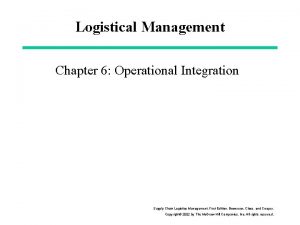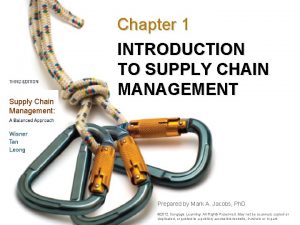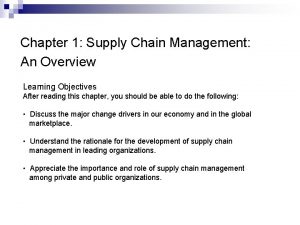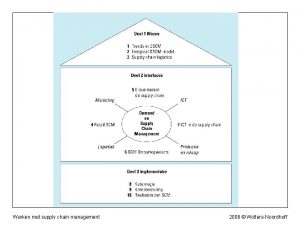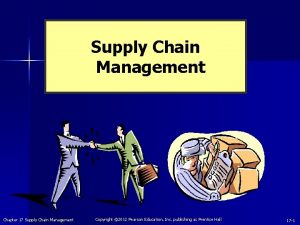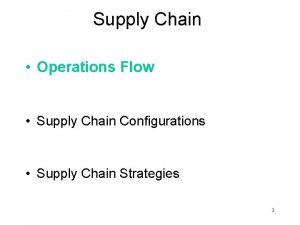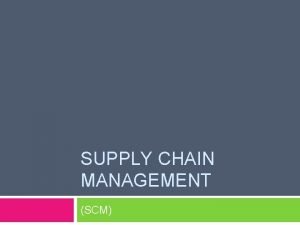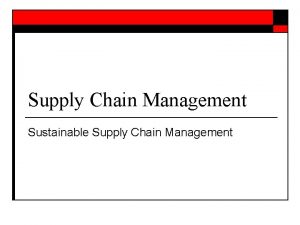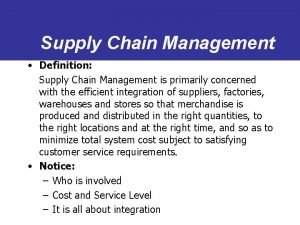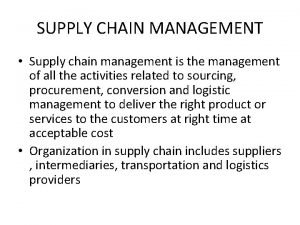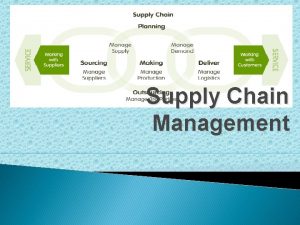Supply Chain Management 2 nd Edition Chapter 9
















- Slides: 16

Supply Chain Management (2 nd Edition) Chapter 9 Planning Supply and Demand in a Supply Chain: Managing Predictable Variability © 2004 Prentice-Hall, Inc. 9 -1

Outline u Responding to predictable variability in a supply chain u Managing supply u Managing demand u Implementing solutions to predictable variability in practice © 2004 Prentice-Hall, Inc. 2

Responding to Predictable Variability in a Supply Chain u Predictable variability is change in demand that can be forecasted u Can cause increased costs and decreased responsiveness in the supply chain u A firm can handle predictable variability using two broad approaches: – Manage supply using capacity, inventory, subcontracting, and backlogs – Manage demand using short-term price discounts and trade promotions © 2004 Prentice-Hall, Inc. 3

Managing Supply u Managing – – – capacity Time flexibility from workforce Use of seasonal workforce Use of subcontracting Use of dual facilities – dedicated and flexible Designing product flexibility into production processes u Managing inventory – Using common components across multiple products – Building inventory of high demand or predictable demand products © 2004 Prentice-Hall, Inc. 4

Inventory/Capacity Trade-off u Leveling capacity forces inventory to build up in anticipation of seasonal variation in demand u Carrying low levels of inventory requires capacity to vary with seasonal variation in demand or enough capacity to cover peak demand during season © 2004 Prentice-Hall, Inc. 5

Managing Demand u Promotion u Pricing u Timing of promotion and pricing changes is important u Demand increases can result from a combination of three factors: – Market growth (increased sales, increased market size) – Stealing share (increased sales, same market size) – Forward buying (same sales, same market size) © 2004 Prentice-Hall, Inc. 6

Demand Management u Pricing and aggregate planning must be done jointly u Factors affecting discount timing – Product margin: Impact of higher margin ($40 instead of $31) – Consumption: Changing fraction of increase coming from forward buy (100% increase in consumption instead of 10% increase) – Forward buy © 2004 Prentice-Hall, Inc. 7

Off-Peak (January) Discount from $40 to $39 Cost = $421, 915, Revenue = $643, 400, Profit = $221, 485 © 2004 Prentice-Hall, Inc. 8

Peak (April) Discount from $40 to $39 Cost = $438, 857, Revenue = $650, 140, Profit = $211, 283 © 2004 Prentice-Hall, Inc. 9

January Discount: 100% Increase in Consumption, Sale Price = $40 ($39) Off-peak discount: Cost = $456, 750, Revenue = $699, 560 © 2004 Prentice-Hall, Inc. 10

Peak (April) Discount: 100% Increase in Consumption, Sale Price = $40 ($39) Peak discount: Cost = $536, 200, Revenue = $783, 520 © 2004 Prentice-Hall, Inc. 11

Performance Under Different Scenarios © 2004 Prentice-Hall, Inc. 12

Factors Affecting Promotion Timing © 2004 Prentice-Hall, Inc. 13

Factors Influencing Discount Timing u Impact of discount on consumption u Impact of discount on forward buy u Product margin © 2004 Prentice-Hall, Inc. 14

Implementing Solutions to Predictable Variability in Practice u Coordinate planning across enterprises in the supply chain u Take predictable variability into account when making strategic decisions u Preempt, do not just react to, predictable variability © 2004 Prentice-Hall, Inc. 15

Summary of Learning Objectives u How can supply be managed to improve synchronization in the supply chain in the face of predictable variability? u How can demand be managed to improve synchronization in the supply chain in the face of predictable variability? u How can aggregate planning be used to maximize profitability when faced with predictable variability in the supply chain? © 2004 Prentice-Hall, Inc. 16
 Supply chain management sunil chopra 6th edition ppt
Supply chain management sunil chopra 6th edition ppt Functional components of ecrm
Functional components of ecrm Contemporary management theory ppt
Contemporary management theory ppt Chain sequence
Chain sequence Matching supply and demand in supply chain
Matching supply and demand in supply chain Operational integration in logistics
Operational integration in logistics Chapter 1 supply chain management
Chapter 1 supply chain management Chapter 6 supply chain management
Chapter 6 supply chain management Dell supply chain case study
Dell supply chain case study Chapter 1 supply chain management
Chapter 1 supply chain management Difference between logistics and supply chain
Difference between logistics and supply chain Sequence of food chain
Sequence of food chain Werken met supply chain management noordhoff
Werken met supply chain management noordhoff Ibm smart supply chain
Ibm smart supply chain Supply chain risk management framework
Supply chain risk management framework Supply chain risk management framework
Supply chain risk management framework Risk assessment likelihood
Risk assessment likelihood





